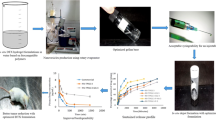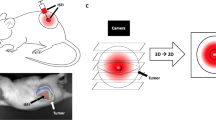Abstract
Our previous studies revealed that the PLGA-based particulate systems loaded with cucurbitacin showed limited anti-melanoma efficiency in xenograft animal models after intratumoral injection, which was due to the undesirable initial burst release and the leakage of the particulate carriers from the injection site through the pinhole. In this paper, two categories of in situ-forming implants (ISFIs) for intratumoral injection, PLGA ISFIs and SAIB ISFIs, were systemically evaluated for their potentials for on solid tumor treatment via intratumoral injection. The in vitro drug release profiles of these two ISFIs were different due to the different sol–gel transition properties. The pharmacodynamics results revealed that SAIB ISFIs displayed obvious therapeutic efficiencies to melanoma, and multi-points injection of SASIB ISFIs displayed better efficiency than single-point injection. The different sol–gel transition properties and mechanism for PLGA ISFIs and SAIB ISFIs affected both the drug release and strongly impacted the pharmacokinetic parameters and pharmacodynamic effectiveness. Also, the adhesive property of SAIB to the local tissue could extend the retention and inhibit the leakage of the SAIB ISFIs, thus enhanced the anticancer effectiveness. Comparison of the various intratumoral injection systems, appropriate drug release profiles (lower initial burst and steady release) and good retention (minimum leakage from the injection site) would benefit to the antitumor effects of the intratumoral depots.











Similar content being viewed by others
References
Guo JB, Li X, Yu HD, Tang ZH, Tang X, Cai CC, et al. The anti-melanoma efficiency of the intratumoral injection of cucurbitacin-loaded sustained-release carriers: A PLGA particle system. J Pharm Sci. 2013;102:2550–63.
Dunn RL, Cowsar DR, Vanderbilt DP. Biodegradable in situ forming implants and methods of producing the same. 1990;U.S. Patent 4,938,763.
Shively ML, Coonts BA, Renner WD, Southard JL, Bennett AT. Physico-chemical characterization of polymeric injectable implant delivery system. J Control Release. 1995;33:237–43.
Dunn RL, Tipton AJ. Polymeric compositions useful as controlled release implant. 1997; U.S. Patent 5,702,716
Eliaz RE, Kost J. Characterization of a polymeric PLGA-injectable implant delivery system for the controlled release of proteins. J Biomed Mater Res. 2000;50:388–96.
Wang L, Kleiner L, Venkatraman S. Structure formation in injectable poly(lactide-co-glycolide) depots. J Control Release. 2003;90:345–54.
Mank R, Rafler G, Nerlich B. Parenterale Depotarzneiformen auf der Basis von biologisch abbaubaren Polymeren. Pharmazie. 1991;46:9–17.
Kempe S, Mäder K. In situ forming implants-an attractive formulation principle for parenteral depot formulations. J Control Release. 2012;161:668–79.
Rhee YS, Park CW, DeLuca PP, Mansour HM. Sustained release injectable drug delivery systems. Pharm Tech. 2010;11(1):s6–s13.
Chandrashekar G, Udupa N. Biodegradable injectable implant system for long term drug delivery using poly (lactic-co-glycolic) acid copolymers. J Pharm Pharmacol. 1996;48:669–74.
Tang Y, Singh J. Controlled delivery of aspirin: effect of aspirin on polymer degradation an in vitro release from PLGA based phase sensitive systems. Int J Pharm. 2008;357:119–25.
Ravivarapu HB, Moyer KL, Dunn RL. Sustained activity and release of leuprolide acetate from a situ forming polymeric implant. AAPS Pharm Sci Technol. 2000;1(1):1–8.
Lambert WJ, Peck KD. Development of an in situ forming biodegradable poly-lactide-co-glycolide system for the controlled release of proteins. J Control Release. 1995;33:189–95.
Lu Y, Yu Y, Tang X. Sucrose acetate isobutyrate as an in situ forming system for sustained risperidone release. J Pharm Sci. 2007;96:3252–62.
Franklin WO, Dao LN, Fielderb PJ, Dybdalb N, Brooksa D, Sanea S, et al. Sustained delivery of human growth hormone from a novel gel system: SABER™. Biomaterials. 2002;23:4353–8.
Royals MA, Fujita SM, Yewey GL, Rodriguez J, Schultheiss PC, Dunn RL. Biocompatibility of a biodegradable in situ forming implant system in rhesus monkeys. J Biomed Mater Res. 1999;45:231–9.
Dong Xiaohui, The preparation of Cuc liposomes, The Master degree thesis of Shenyang Pharmaceutical University, 2008
Pechenov S, Shenoy B, Yang MX. Injectable controlled release formulations incorporating protein crystals. J Control Release. 2004;96:149–58.
Wang L, Wang A, Zhao X, Liu X, Wang D, Sun F, et al. Design of a long-term antipsychotic in situ forming implant and its release control method and mechanism. Int J Pharm. 2012;427:284–92.
Lin X, Yang S, Gou J, Zhao M, Zhang Y, Qi N, et al. A novel risperidone-loaded SAIB-PLGA mixture matrix depot with a reduced burst release: effects of solvents and PLGA on drug release behaviors in vitro/in vivo. J Mater Sci Mater Med. 2012;23:443–55.
Schoenhammer K, Petersen H, Guethlein F, Goepferich A. Poly-ethyleneglycol 500 dimethylether as novel solvent for injectable in situ forming depots. Pharm Res. 2009;26:2568–77.
Kranz H, Bodmeier R. Structure formation and characterization of injectable drug loaded biodegradable devices: in situ implants versus in situ microparticles. Eur J Pharm Sci. 2008;34:164–72.
Chakravarthi SS, De S, Miller DW, Robinson DH. Comparison of anti-tumor efficacy of paclitaxel delivered in nano- and microparticles. Int J Pharm. 2010;383:37–44.
Rowe RC, Sheskey PJ, Quinn ME. Handbook of pharmaceutical excipients (6th edition), Pharmaceutical Press and the American Pharmacists Association, USA. 2009; pp. 17 (ethanol), 233 (DMSO), and 601 (NMP).
Chhabra S, Sachdeva V, Singh S. Influence of end groups on in vitro release and biological activity of lysozyme from a phase-sensitive smart polymer-based in situ gel forming controlled release drug delivery system. Int J Pharm. 2007;342:72–7.
Liu Q, Zhang H, Zhou G, Xie S, Zou H, Yu Y, et al. In vitro and in vivo study of thymosin alpha1 biodegradable in situ forming poly(lactide-co-glycolide) implants. Int J Pharm. 2010;397:122–9.
Luan X, Bodmeier R. Influence of the poly (lactide-co-glycolide) type on the leuprolide release from in situ forming microparticle systems. J Control Release. 2006;110:266–72.
Lambert WJ, Peck KD. Development of an in situ forming biodegradable poly-lactide-coglycolide system for the controlled release of proteins. J Control Release. 1995;33:189–95.
Hatim A, Catherine O, Somnath S. In vitro-controlled release delivery system for hydrogen sulfide donor. AAPS Pharm Sci Tech. 2014;15(4):910–9.
Graham PD, Brodbeck KJ, McHugh AJ. Phase inversion dynamics of PLGA solutions related to drug delivery. J Control Release. 1999;58:233–45.
Luan X, Bodmeier R. In situ forming microparticle system for controlled delivery of leuprolide acetate: influence of the formulation and processing parameters. Eur J Pharm Sci. 2006;27:143–9.
Tarek AA, Hany MI, Ahmed MS, Alaa K, Mohammad T, Nutan H, et al. Biodegradable injectable in situ implants and microparticles for sustained release of montelukast: in vitro release, pharmacokinetics, and stability. AAPS Pharm Sci Tech. 2014;15(3):772–80.
Dong WY, Körber M, Esguerra VL. Stability of poly (d,l-lactide-co-glycolide) and leuprolide acetate in situ forming drug delivery systems. J Control Release. 2006;115:158–67.
Brodbeck KJ, DesNoyer JR, McHugh AJ. Phase inversion dynamics of PLGA solutions related to drug delivery-part II. The role of solution thermodynamics and bath-side mass transfer. J Control Release. 1999;62:333–44.
Frank A. Factors affecting the degradation and drug-release mechanism of poly (lactic acid) and poly [(lactic acid)-co-(glycolic acid)]. Polym Int. 2005;54:36–6.
Gao ZB, Ding PT, Zhang L. Study of a Pingyangmycin delivery system: Zein/Zein–SAIB in situ gels. Int J Pharm. 2007;328:57–64.
Yu J, Yin D, Min X, Guo Z, Zhang J, Wang Y, et al. [188Re] Rhenium sulfide suspension: a potential radiopharmaceutical for tumor treatment following intra-tumor injection. Nucl Med Biol. 1999;26:573–9.
Ewelina K, Sin YY, Sophie S, Daisy WJ, Boekhovena RW, Raymond MS, et al. Anti-tumor activity of liposomal glucocorticoids: the relevance of liposome-mediated drug delivery, intratumoral localization and systemic activity. J Control Release. 2011;151:10–7.
Acknowledgments
We thank Prof. Deng Yihui, Shenyang Pharmaceutical University, for his helpful comments on animal studies, Mr. Tian Han, Zhongshan School of Medicine, SUN YAT-SEN University, for his help on cellular experiments and results explanations, and Prof. Takshi Ikejima, Shenyang Pharmaceutical University, who kindly provided the A375.S2 human melanoma cell.
Author information
Authors and Affiliations
Corresponding author
Electronic Supplementary Material
Below is the link to the electronic supplementary material.
Supplementary Figure 1
(DOC 1644 kb)
Supplementary Figure 2
(DOC 50 kb)
(AVI 670 kb)
(AVI 831 kb)
Rights and permissions
About this article
Cite this article
Guo, J., Wang, J., Cai, C. et al. The Anti-Melanoma Efficiency of the Intratumoral Injection of Cucurbitacin-Loaded Sustained Release Carriers: In Situ-Forming Implants. AAPS PharmSciTech 16, 973–985 (2015). https://doi.org/10.1208/s12249-015-0292-2
Received:
Accepted:
Published:
Issue Date:
DOI: https://doi.org/10.1208/s12249-015-0292-2




